Evaluating the FER of IEEE 802.15.4 Frames Between UAVs and Wireless Sensor Nodes †
Abstract
1. Introduction
2. Related Work
3. Proposed Solution
3.1. Design Considerations
3.2. System Components
3.2.1. Ground Control Station
3.2.2. Transmitter Node
3.2.3. Wireless Sensor Nodes
3.3. Algorithms for the Operation of the Communications System
3.3.1. Algorithm for the GCS
- Send its unique address (SRC_ADDR) to the application to know if the node is operating correctly, and the latter can send or receive data from the application.
- Send several frames to the transmitting node with each of the instructions (entered in the application) that the transmitting node must take into account to execute its main function of sending frames.
- Send the data from the transmitting node, previously stored, to the application.
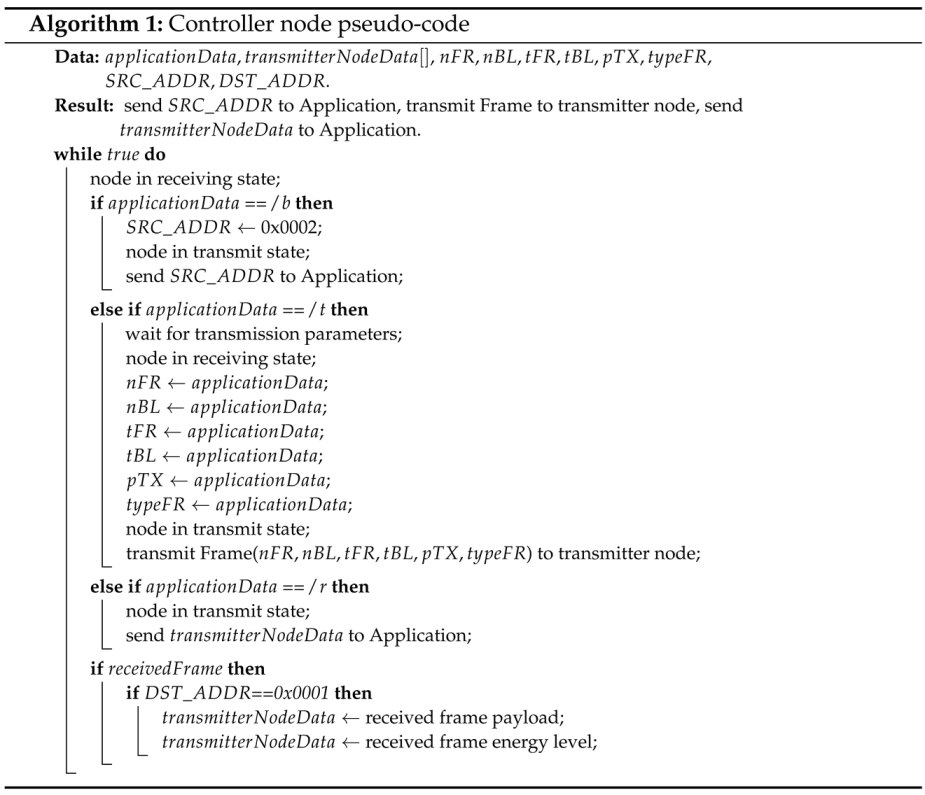
3.3.2. Algorithm for the Transmitter Node
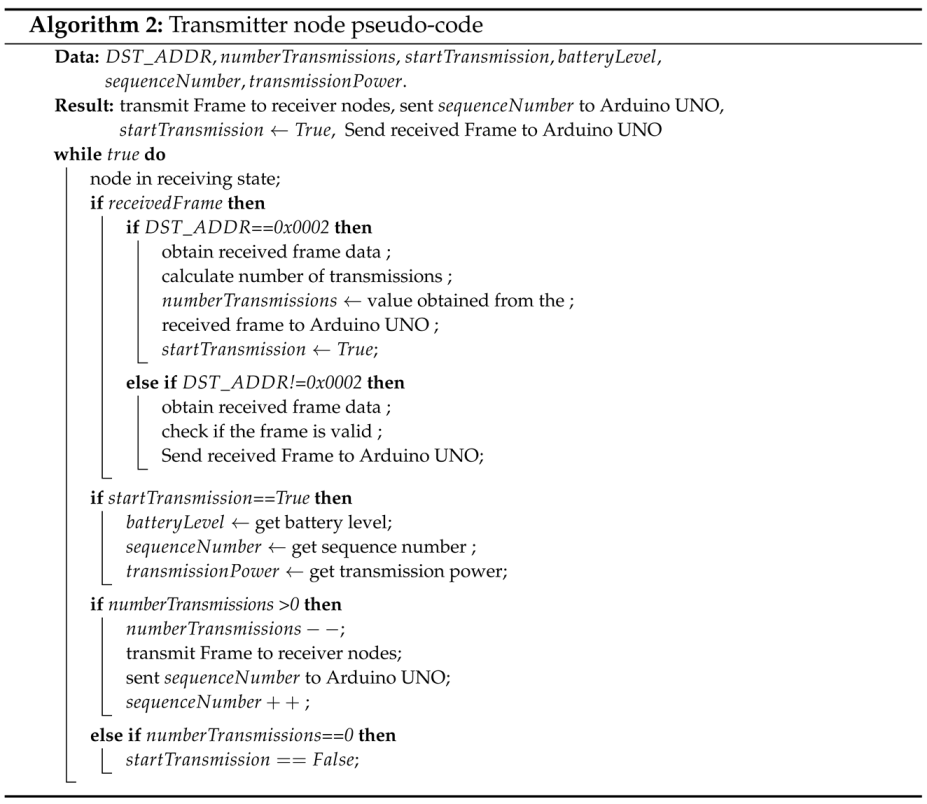
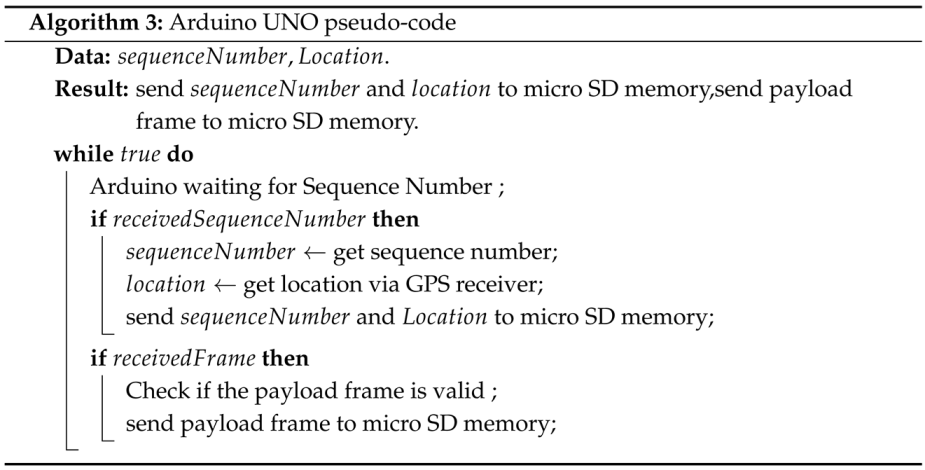
3.3.3. Algorithm for the Wireless Sensor Nodes

3.4. Implementation
| Features | Specifications |
|---|---|
| Communication | Half Duplex |
| Standard | IEEE 802.15.4—2006 |
| Cyclic Redundancy Check | CRC 16 |
| Acknowledgments | ACK |
| Frame Control | Transmission, Reception, and Retransmission |
| Medium Access Method | CSMA-CA |
| Data Rates | 250 Kbps, 500 Kbps, 1 Mbps, 2 Mbps |
| Receiver Sensitivity | −100 dBm |
| Transmit Power | −17 dBm to 3.5 dBm |
| PLL Synthesizer | 5 MHz Channel Spacing |
| Buffer | 128 Bytes |
| Temperature Range | −40 °C to 125 °C |
| Power Consumption | 1.8 V to 3.6 V (10.1 mA to 18.6 mA) |
| Applications | ZigBee, ISM, IEEE 802.15.4, RF4CE, SP100, WirelessHART, 6LoWPAN |
4. Tests and Results
- Frame loss due to noise and interference on the channel, caused because the frequency band is shared with the IEEE 802.11 standard (APs deployed mainly in channels 1, 6, and 11, with RSSIs between −68 dBm and −55 dBm [15]).
- Even when there is no noise or interference, frames are lost because the sensor node cannot receive and process them simultaneously, as is done in the IEEE 802.11 standard. This feature sometimes prevents the frame from being received and stored. The time interval at which the node processes information varies and depends on each application. The proposed tool can adjust the frame sending frequency to determine the minimum interval between frames that the receiving node can receive and process. This function of varying the interval between frames transmitted by the node was successfully tested, obtaining different FER values.
5. Conclusions
Author Contributions
Funding
Data Availability Statement
Conflicts of Interest
References
- Islam, N.; Rashid, M.M.; Pasandideh, F.; Ray, B.; Moore, S.; Kadel, R. A Review of Applications and Communication Technologies for Internet of Things (IoT) and Unmanned Aerial Vehicle (UAV) Based Sustainable Smart Farming. Sustainability 2021, 13, 1821. [Google Scholar] [CrossRef]
- Gislason, D. Zigbee Wireless Networking; Newnes: Burlington, MA, USA, 2008. [Google Scholar]
- Yang, Z.; Chang, C.H. 6LoWPAN Overview and Implementations. In Proceedings of the 2019 International Conference on Embedded Wireless Systems and Networks, EWSN ’19, Beijing, China, 25–27 February 2019; pp. 357–361. [Google Scholar]
- Queiroz, D.V.; Alencar, M.S.; Gomes, R.D.; Fonseca, I.E.; Benavente-Peces, C. Survey and systematic mapping of industrial Wireless Sensor Networks. J. Netw. Comput. Appl. 2017, 97, 96–125. [Google Scholar] [CrossRef]
- Sen, S.K. ISA100.11a. In Fieldbus and Networking in Process Automation, 2nd ed.; CRC Press: Boca Raton, FL, USA, 2021. [Google Scholar]
- Biswas, S.; Ghosh, B.; Chandra, A.; Dhar Roy, S. Frame error rate for single-hop and dual-hop transmissions in 802.15.4 LoWPANs. Int. J. Electron. 2017, 104, 1413–1426. [Google Scholar] [CrossRef]
- Cheng, M.; Guan, Q.; Wang, Q.; Ji, F.; Quek, T.Q.S. FER-Restricted AUV-Relaying Data Collection in Underwater Acoustic Sensor Networks. IEEE Trans. Wirel. Commun. 2023, 22, 9131–9142. [Google Scholar] [CrossRef]
- Zhu, L.; Gu, L.; Chen, R. A retransmission scheme in IEEE 802.11be synchronized multi-link WLANs. IEICE Trans. Fundam. Electron. Commun. Comput. Sci. 2022, E106.A, 871–875. [Google Scholar] [CrossRef]
- Mezghanni, M.S.; Kandil, N.; Hakem, N. IEEE 802.15.4 performance evaluation for the underground mine radio-channel. In Proceedings of the 2016 IEEE International Symposium on Antennas and Propagation (APSURSI), Fajardo, Puerto Rico, 26 June–1 July 2016; pp. 2057–2058. [Google Scholar] [CrossRef]
- Théophile Elise, D.; Thomas, R.; Antonio, F.; Michel, M. Feedback on a fortification technique for exchanges of 802.15.4 data frames for real-time, critical data collection application. In Proceedings of the 2023 IEEE International Conference on Wireless for Space and Extreme Environments (WiSEE), Aveiro, Portugal, 6–8 September 2023; pp. 122–126. [Google Scholar] [CrossRef]
- Zhang, Q.; Liu, B.; Chen, G.; Zhan, S.; Li, Z.; Zhang, J.; Jiang, N.; Cao, B.; Li, Z. An Improved Adaptive Coding and Modulation Scheme with Hybrid Switching Standard for UAV-to-Ground Free Space Optical Communication. IEEE Photonics J. 2024, 16, 7300108. [Google Scholar] [CrossRef]
- Dakić, A.; Hofer, M.; Rainer, B.; Zelenbaba, S.; Bernadó, L.; Zemen, T. Real-Time Vehicular Wireless System-Level Simulation. IEEE Access 2021, 9, 23202–23217. [Google Scholar] [CrossRef]
- Acosta, C.E.; Gil-Castiñeira, F.; Costa-Montenegro, E.; Silva, J.S. Reliable Link Level Routing Algorithm in Pipeline Monitoring Using Implicit Acknowledgements. Sensors 2021, 21, 968. [Google Scholar] [CrossRef] [PubMed]
- Carvajal-Rodriguez, J.; Tipantuña, C.; Acosta, C.E.; Cajamarca, L.C.; Montalván, S.; Vinueza, M. Algorithm to Collect Data with a UAV in an IEEE 802.15.4 Sensor Network with Linear Topology. In Proceedings of the IEEE Latin-American Conference on Communications (LATINCOM), Medellin, Colombia, 6–8 November 2024; pp. 1–6. [Google Scholar] [CrossRef]
- Carvajal, J.; Egas, C.; Criollo, L.; Tipantuña, C.; Montalván, S.; Quizhpe, J. Evaluating the FER of IEEE 802.15.4 Frames Between a UAV and Wireless Sensor Nodes: Repository of Controller, Transmitter Node, and Wireless Nodes. 2024. Available online: https://github.com/criolloluis410/Application-to-manage-transmissions-and-Code-for-ATZB-256RFR2-XPRO-Nodes (accessed on 10 August 2025).
- Egas Acosta, C.; Cali, D.; Espinosa, C. Autoconfiguration with Global Addresses Using IEEE 802.15.4 Standard in Multi-Hop Networks. Enfoque UTE 2021, 12, 44–58. [Google Scholar] [CrossRef]
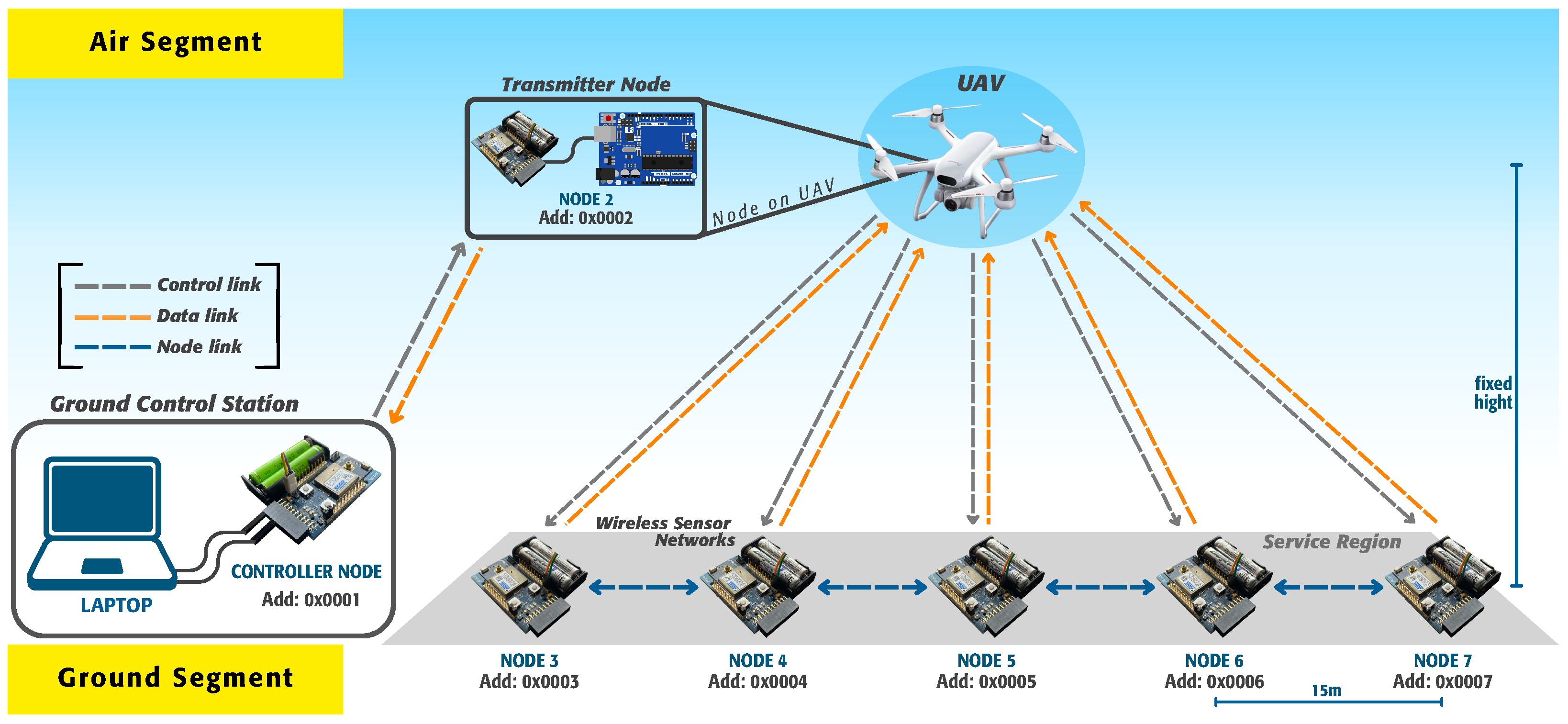
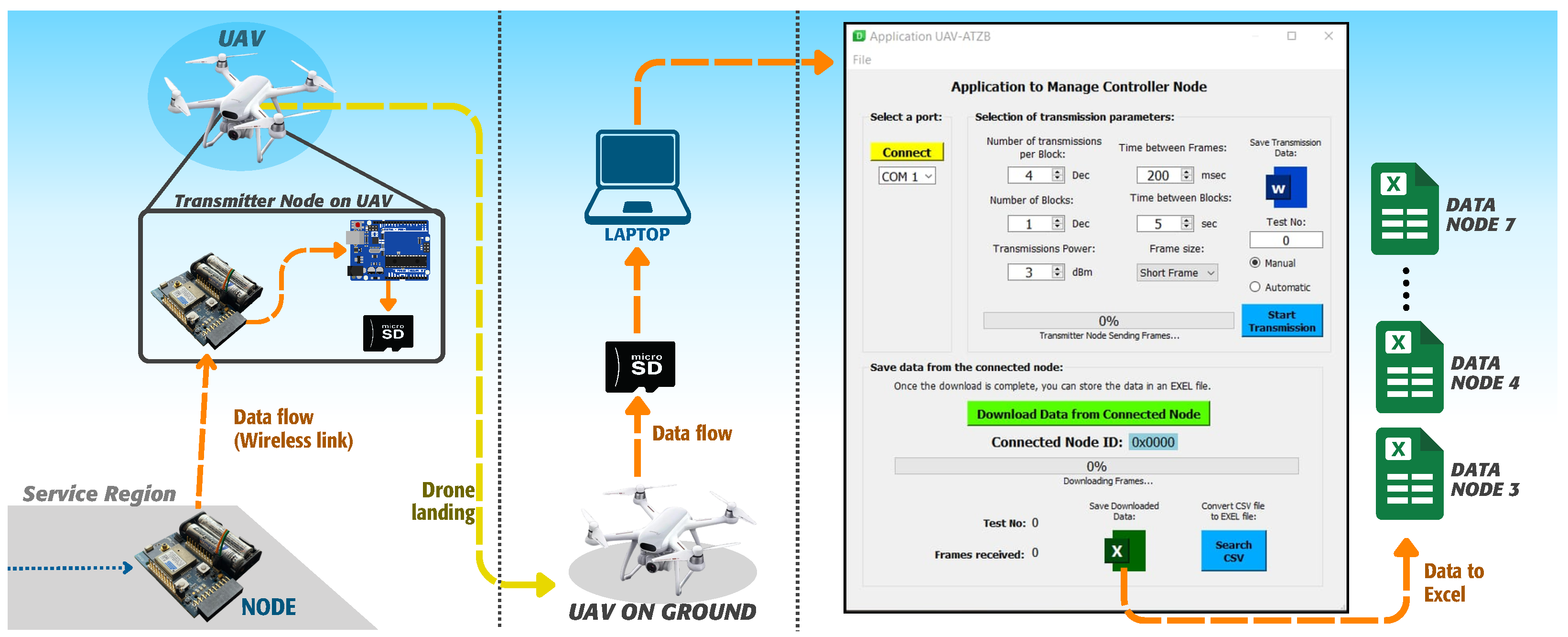

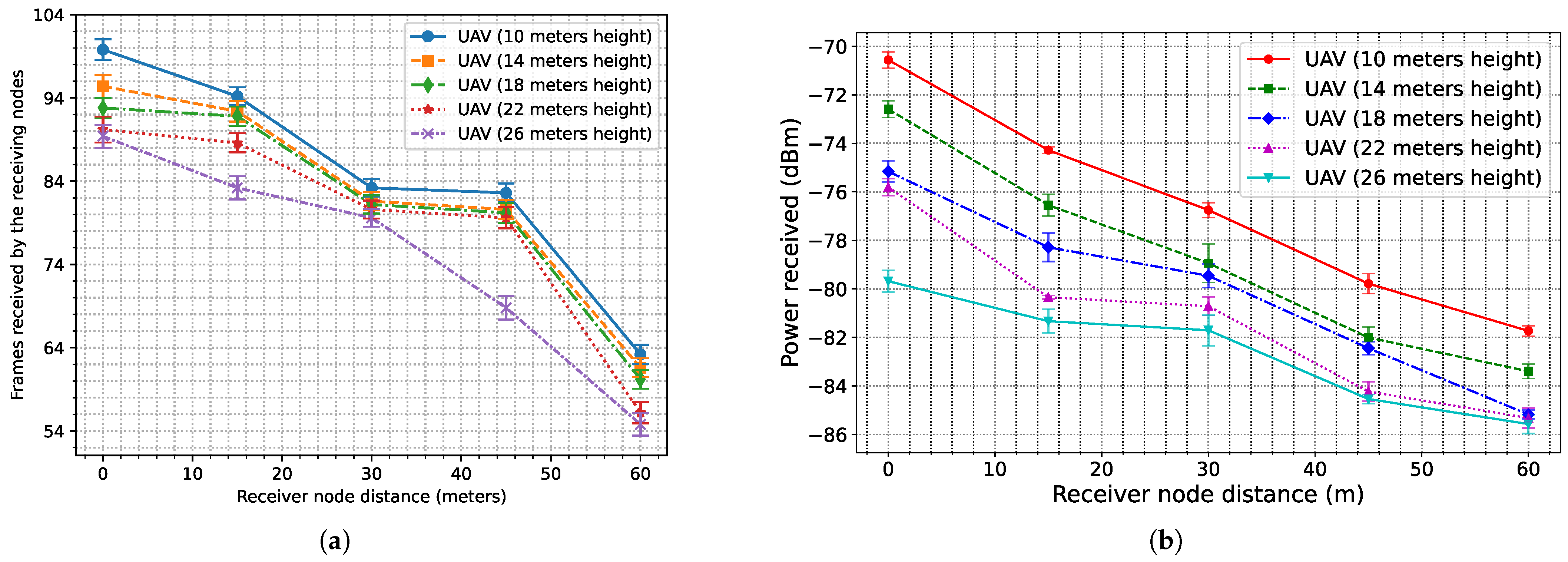
| Receiver Node | UAV at 10 m | UAV at 14 m | UAV at 18 m | UAV at 22 m | UAV at 26 m |
|---|---|---|---|---|---|
| 0x0003 | 0.2 | 4.6 | 7.2 | 9.8 | 10.6 |
| 0x0004 | 5.8 | 7.6 | 8.2 | 11.4 | 16.8 |
| 0x0005 | 16.8 | 18.4 | 18.8 | 19.4 | 20.4 |
| 0x0006 | 17.4 | 19.4 | 19.8 | 20.4 | 31.2 |
| 0x0007 | 36.8 | 38.4 | 39.8 | 43.8 | 45.2 |
Disclaimer/Publisher’s Note: The statements, opinions and data contained in all publications are solely those of the individual author(s) and contributor(s) and not of MDPI and/or the editor(s). MDPI and/or the editor(s) disclaim responsibility for any injury to people or property resulting from any ideas, methods, instructions or products referred to in the content. |
© 2025 by the authors. Licensee MDPI, Basel, Switzerland. This article is an open access article distributed under the terms and conditions of the Creative Commons Attribution (CC BY) license (https://creativecommons.org/licenses/by/4.0/).
Share and Cite
Tipantuña, C.; Egas Acosta, C.; Criollo, L.; Carvajal-Rodriguez, J.; Montalván, S.; Quizhpe, J.; Hesselbach, X.; Shagñay, J. Evaluating the FER of IEEE 802.15.4 Frames Between UAVs and Wireless Sensor Nodes. Eng. Proc. 2025, 115, 20. https://doi.org/10.3390/engproc2025115020
Tipantuña C, Egas Acosta C, Criollo L, Carvajal-Rodriguez J, Montalván S, Quizhpe J, Hesselbach X, Shagñay J. Evaluating the FER of IEEE 802.15.4 Frames Between UAVs and Wireless Sensor Nodes. Engineering Proceedings. 2025; 115(1):20. https://doi.org/10.3390/engproc2025115020
Chicago/Turabian StyleTipantuña, Christian, Carlos Egas Acosta, Luis Criollo, Jorge Carvajal-Rodriguez, Saúl Montalván, Jonathan Quizhpe, Xavier Hesselbach, and Jessica Shagñay. 2025. "Evaluating the FER of IEEE 802.15.4 Frames Between UAVs and Wireless Sensor Nodes" Engineering Proceedings 115, no. 1: 20. https://doi.org/10.3390/engproc2025115020
APA StyleTipantuña, C., Egas Acosta, C., Criollo, L., Carvajal-Rodriguez, J., Montalván, S., Quizhpe, J., Hesselbach, X., & Shagñay, J. (2025). Evaluating the FER of IEEE 802.15.4 Frames Between UAVs and Wireless Sensor Nodes. Engineering Proceedings, 115(1), 20. https://doi.org/10.3390/engproc2025115020






